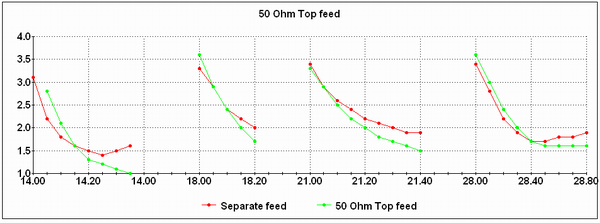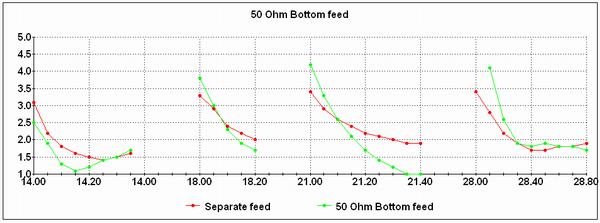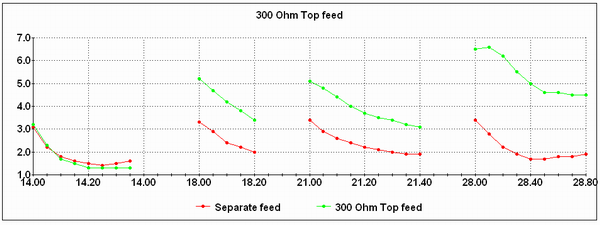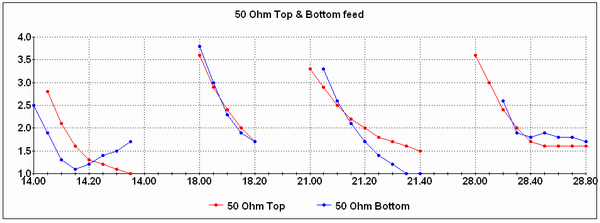Classic Hexbeam - Measurements (Part 2)
Whilst I was re-building my 4 band Classic Hexbeam I took the opportunity to make some SWR measurements using the alternative interconnection arrangements that were discussed in the Multiband Matching section of this site. The results are presented in the following charts. Please note that these measurements were made with the beam on a temporary mast - closer to the ground than its final position; therefore the SWR curves for the 50 Ohm Top feed case differ in some measure from those for the beam at full height which were presented in Measurements (Part1). Nevertheless the impact of the different interconnection options is clear.

The chart above shows, in green, the SWR performance across the 4 bands using 50 Ohm coax as the interconnecting cable and feeding at the Top (20m) position. For reference also shown, in red, is the SWR performance if a separate feed is used to each band position. The 50 Ohm interconnection has produced the expected SWR improvement in the upper half of the bands predicted by EZNEC. Now let's keep the 50 Ohm interconnection but move the feed position to the bottom (10m) position:

On 20m, 17m and 15m the presence of the interconnecting coax has again generally produced an improvement in SWR. There is some minor degradation of the 10m performance, however this feed arrangement appears to deliver quite acceptable performance and is little different from the 50 Ohm Top fed case.

The chart above shows how things changed dramatically when I moved to 300 Ohm "window" for the interconnecting cable and fed the beam at the Top (20m) position. You can see that there is a modest improvement to the 20m performance resulting from the shunt capacitance effect of the cable; but the SWR on the other bands has degraded very significantly. This was the expected result - the 300 Ohm line has transformed the impedance of the other bands, the 10m band being affected most because it is furthest from the 20m feedpoint.

Retaining the 300 Ohm interconnect, but moving the feedpoint to the Bottom (10m) position produced the results above. Again, they are as expected. The shunt capacitance has improved the 10m SWR, but the impedance transformation introduced by the cable has severely damaged the 20m and 17m performance. Interestingly the 15m SWR has improved; one explanation is that, because the distance between the 15m elements and the 10m feedpoint is short the impact of the impedance transformation is modest and is outweighed by the benefit of the shunt capacitance.
These results do not preclude the use of 300 Ohm for the interconnections; but they do underline that significant shortening of the Drivers would be necessary to reduce the SWR to acceptable levels.
Because the 50 Ohm Top and Bottom feed results are so similar, I have plotted them on the same chart, below, so that a direct comparison between the two can be made:

There is little to choose between the two arrangements: results on 17m are almost identical; Bottom feed shows benefit on 15m, and Top feed produces better results on 10m; Top feeding produced better results over the upper half of the 20m, band, whilst Bottom feeding was better at the lower frequencies. EZNEC modelling had shown Top feeding, overall, to be the slightly better SWR compromise, but these results would suggest there is very little practical difference between the two approaches.